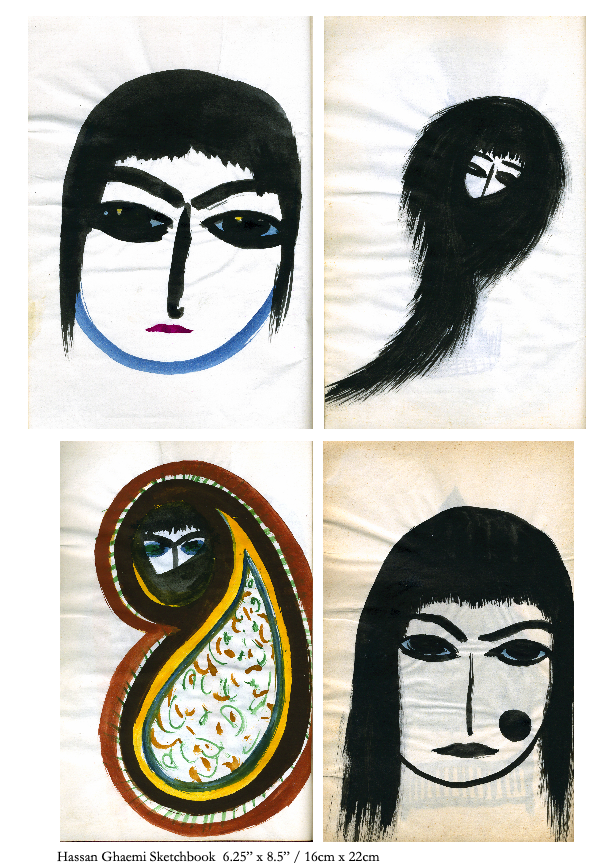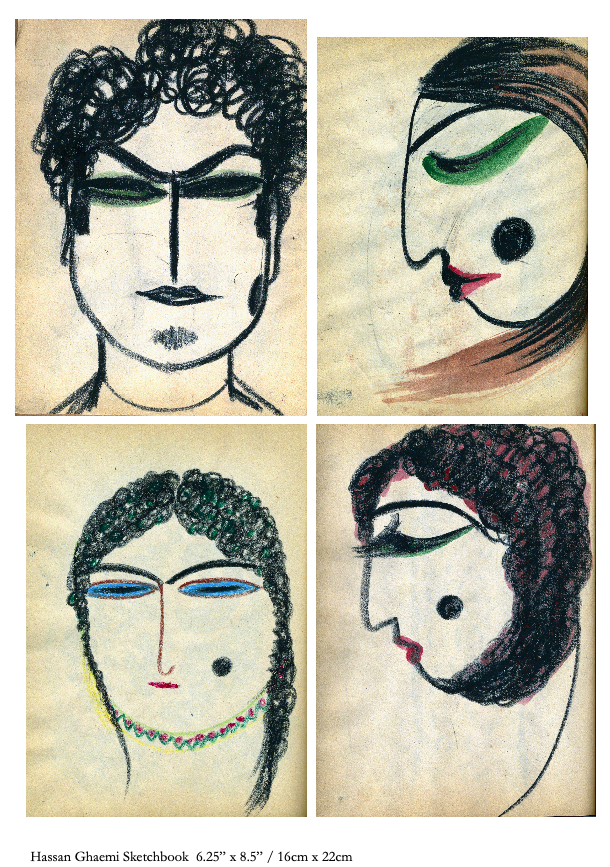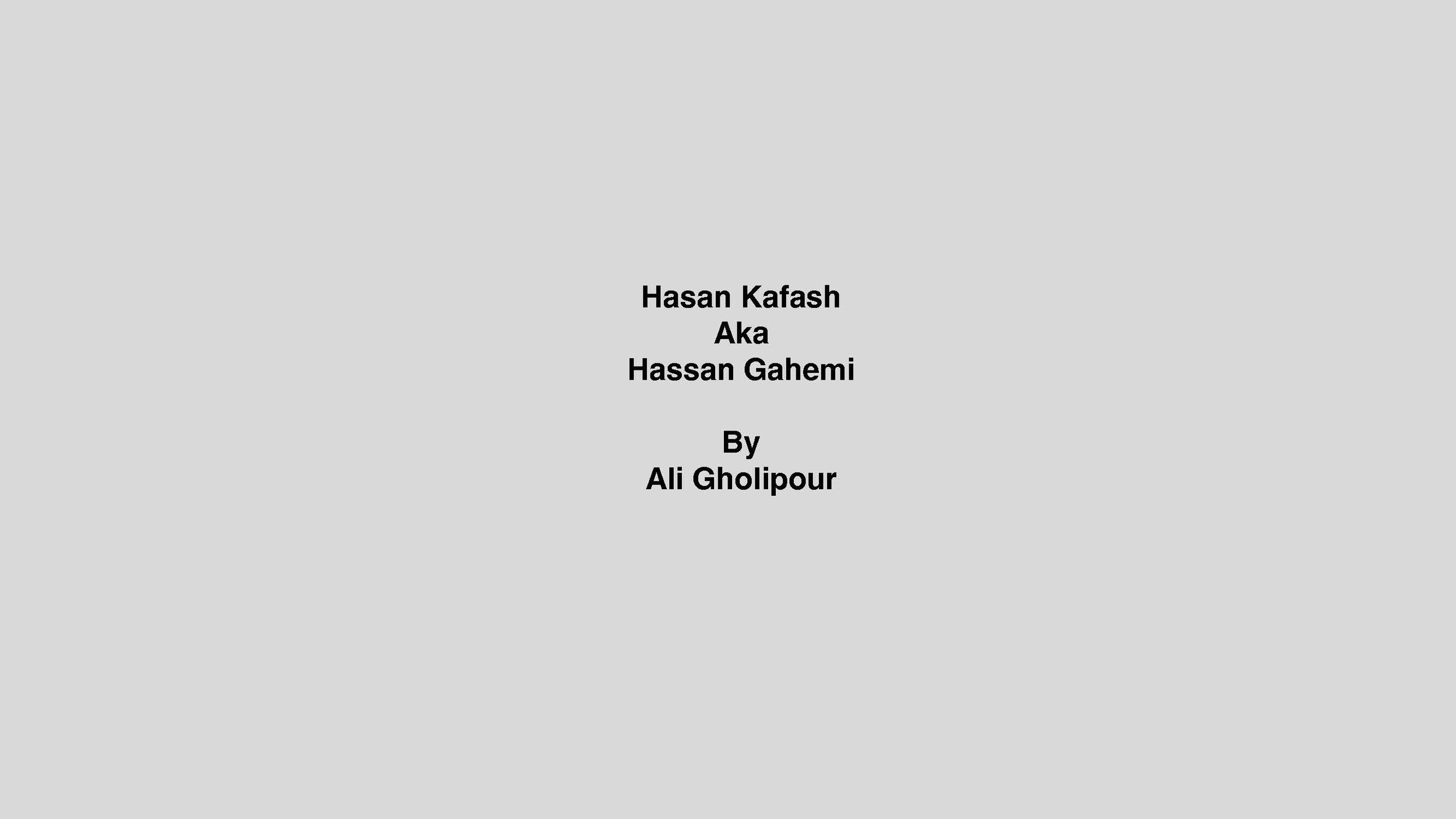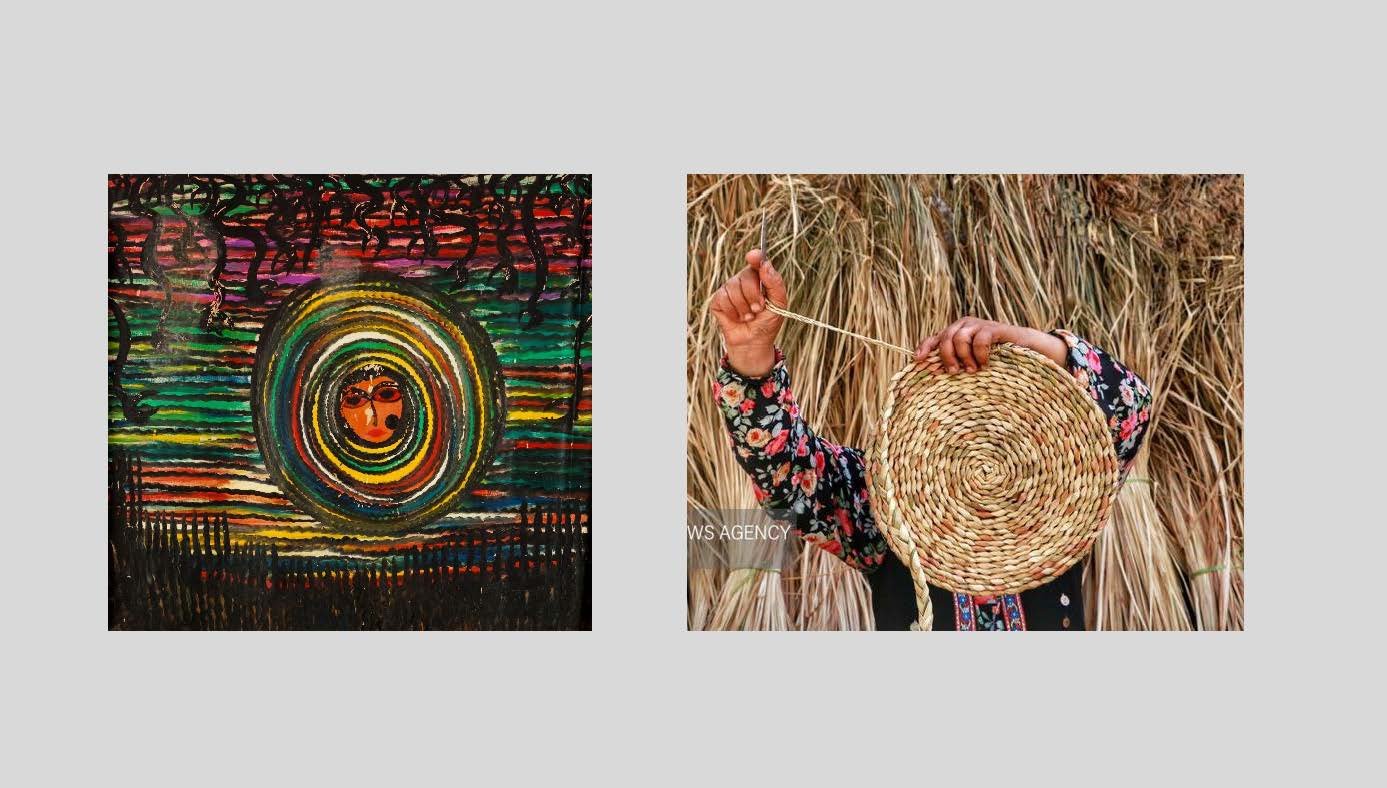HASSAN GHAEMI
Hassan Ghaemi (1933 – 2016), Iranian painter and poet.
Hassan Ghaemi was an artist and poet who was a central figure in the Iranian Modernist movement of the 1960 - 1970s and known for his colourful large scale depictions of the ethnic Gilaki women of the Caspian Sea region in northern Iran. Initially receiving both local and international acclaim, Ghaemi’s work has been obscured by historical events and the vagaries of life. Ghaemi was an ethnic minority and self taught. His subject matter was almost exclusively women (and gender). His art was and remains difficult to categorise. He was a profoundly important artist, but before his time.
Ghaemi was a peer and friends with many of the now well known Iranian modern artists of the period including Parvis Tanavoli, Sorab Sepehri, Faramarz Pilaram and Charles Zenderoudi. He lived and worked in rural Iran, Tehran, Paris, London, New York and Los Angeles.
Ghaemi was born in Rasht, also known as the city of rain. Rasht is the capital city of Gilan Province and the largest city on the Caspian Sea coast of Iran. Situated in the north of the desert country, the subtropical Caspian region holds a special place in the broader Iranian culture. Ghaemi’s obsessive subject matter was the (inner) lives and customs of the ethnic Gilaki women of his birthplace.
Retrospectively Ghaemi’s work is singular on almost every level: style, scale, locale, subject and most importantly, perhaps he alone among the other artists of his generation investigates the indigenous, authentic, humanistic, virtually unseen essence of the country, which is it’s people and their culture.
“He was the emotional centre of all of this renaissance in Persian (Modern) Art. It was based on a true area of the country. It went deep in terms of history and the artistic sensibility of the nation. It represents the real true culture of the country away from political considerations.” Eric Azari
Hassan Ghaemi, The Caspian Series
Following is a selection of 20 paintings on canvas and 32 sketch book pages of hundreds, from the largest known collection of Hassan Ghaemi’s work, which contains over 60 full sized paintings, sketchbooks and ephemera.
My parents Eric and Sheila Azari were early collectors and patrons of the arts in Iran in the 1960’s, assembling one of the most important and largest private Iranian modern art collections in the world at that time. They considered Ghaemi to have a distinctly Iranian voice and be the most authentic, humanistic, and important artist in their circle.
HASSAN GHAEMI SELECTED WORKS & BACKGROUND
HASSAN GHAEMI RESEARCH ESSAY
Biography, Hassan Ghaemi (1933- 2016)
Note: Eric and Shelia Azari lost contact with Hassan Ghaemi in the late 1970’s. Darius Azari commissioned this biography which is provisional and know to omit major events in his life such as his artist residence in the Azari’s Tehran household in the late 1960’s. He is survived by his sisters who live in Tehran and know little of his work or life.
Author:
Fatemeh Takhtkeshian
Early life
The painter Hassan Ghaemi was born on 21 March 1933 in Rasht, in the north of Iran to a religious family. Hassan Ghaemi's father Mohammad-Vaez Ghaemi was a clergyman who unfortunately passed away while Hassan was still young. Hassan had a good life until his father's death in 1940; after that he and his mother tasted poverty. This led him to do various jobs from his early age in order to support himself and his mother, hence the nickname ‘Hassan Kafash’ remained on him from these years.
When he was 10 years old in 1944 Ghaemi moved with his mother to Tehran where they rented a room in the predominately Jewish neighbourhood of Sarcheshmeh, Mirza Mahmoud Alley. This cultural backdrop provided the ground for Ghaemi to become acquainted with other religions. Later in life, learning about other religions besides Islam provided inspiration for the creation of his numerous works.
Career
Hassan Ghaemi's early interest in painting didn't meet family approval. In fact, Ghaemi's family never accepted his paintings and despite permanent rejection by his brother for his career choice, Ghaemi continued to paint; claiming the joy of his life was summed up in painting. Initially borrowing an embroidery album from his classmate when he was nine years old, Ghaemi copied all of the patterns into another book; since then he never stopped painting. Until his adulthood he never had a formal art education.
Ghaemi's interest in painting led him to the Ziba advertising company at the age of fifteen in 1948 where he met the Russian graphic artist Alexei Gorgiz -- what Ghaemi considered the most important chance encounter of his life. Gorgiz taught Ghaemi a variety of painting techniques; gradually Ghaemi began to earn money from his paintings and eventually to made a living through painting.
Other contemporary artists in Tehran at the time also helped Hassan Ghaemi develop his artistic direction. Participation in Jalil Ziapour’s art classes in 1951 taught him the history of art and additional painting techniques. It was during these classes that Hassan met fellow artists Parviz Tanavoli, Manouchehr Sheibani and Hossein Mahjobi. During this period, Ghaemi met Sohrab Sepehri in one of the Laleh-Zar’s cafes. The commonalities of Ghaemi and Sepehri led to the formation of a deep friendship, later realised as a joint exhibition in the United States.
Ghaemi was one of the first self-taught artists in Iran. Unlike the other artists at his time, he did not have any academic education in art; it appears that he did not even finish high school. Nonetheless, with the support and recommendations of Iranian artists, he managed to exhibit his artworks in a few galleries. As such in 1958, with Ziapour’s support, Ghaemi exhibited his works (for the first time) in the opening ceremony of the UN Library in Tehran hosted by Gita Society. In the same year he participated in the first Tehran Biennale and was awarded one of the Biennial’s prizes, which included a study opportunity in the United Kingdom. During this trip over the course of two years he also visited galleries and museums in France, Belgium and Italy. In 1959 his second solo exhibition was held in the Esthetic Gallery, followed closely by his third solo exhibition in 1960 at the New Art Gallery, also in Tehran. In the same year Ghaemi also participated in the second Tehran Biennial.
Through the sponsorship of the art collector and owner of Ishtar Gallery in Los Angeles, Eric Azari, Ghaemi moved to the United States in 1960. In the 1960s Azari sponsored a number of Iranian artists such as Parviz Tanavoli, Fereydun Rahimi-Asa and Hassan Ghaemi. Ghaemi’s last exhibition was a joint exhibition with Sohrab Sepehri in Los Angles in 1966. This exhibition was sponsored by the International Student Centre of California University in cooperation with Ishtar Gallery of Art and Archaeology.
Ghaemi lived and worked in the United States for two long periods of time starting in 1960, returning to Iran in 1978. From then until 2015 Hassan Ghaemi was not publicly or professionally an artist although he never stopped producing numerous small drawings and writing poetry. As an outlet for the multiplicity of subjects that occupied his mind and not dependent on financial conditions, Ghaemi executed his drawings on paper with a pen, a technique he continued until the end of his life. In the last year of his life, he also created a number of paintings with acrylic and oil painting on canvas. In addition Ghaemi compiled a collection of his paintings from the mid-1960s, curated according to their influence by Qur'anic verses into a four-volume Qur'an. There are over 24,000 images in this Qur'an. Each of his paintings has an audible story. As for Ghaemi's poetry, with more than a thousand pages of poetry left by him there's no question of his notable output and according to reviewers he was also a good poet.
In 2015 the Iranian Artist Forum (Khane-e Honarmandan-e Iran) in collaboration with the Tandis magazine and Tehran Beautification Organization hosted a commemoration for Hassan Ghaemi and exhibited his works in the Iranian Artist Forum gallery space. This event, after four decades, finally casts light on Hassan Ghaemi and his artworks, introducing him for the second time in his lifetime to the art world. After this ceremony he painted a few large paintings before passing away on 31 March 2016 in Karaj, Iran.
Artistic Legacy
The beginning of Hassan Ghaemi’s artistic career coincides with the formation of modern art in Iran, an atmosphere that helped this artist to find a place in art society and gain acceptance. The question of Iranian identity and how to express it in visual arts was one of the central concerns among the Iranian artists of this period, who through a variety of subjects and themes, tried to represent their national identity in their artworks. Since Hassan Ghaemi had not studied art formally according to any prescribed method, he was able to develop a highly personalised style of art technique and subject. By depicting Gilaki women and men in traditional dress either working in the paddy field or fruit gardens, he made reference to his homeland in the Caspian Sea region of Iran--rather than more directly addressing nationalist concerns. From a formal perspective, Ghaemi's use of colour and line firmly place his artworks within the canon of modern art painting. In his paintings life and happiness surge and fascinate the viewer with its simplicity and purity. His art was seen and appreciated by established artists such as Jazeh Tabatabai and Jalil Ziapour, who praised his direct, emotional approach to his subject matter.
At the beginning of his career Ghaemi was well received by the art community. He was granted an award from the First Tehran Biennial and exhibited his work nationally and internationally. Eventually he fell out of the gaze of art society, re-emerging during the last days of his life to create a few additional paintings. Overall, Ghaemi is one of the most prolific contemporary artists in Iran with about 800 artworks. But why did his name disappear for about four decades? There is no definitive answer to this question, but it may be found in the events of his life. Iran faced dramatic changes in the late 70s that coincided with Ghaemi’s return to Iran. After the Islamic revolution and during the Iran-Iraq war, many artists moved away from the art market. Moreover, due to economic constraints, Ghaemi created small scale drawings which galleries were not eager to exhibit. One might also point to his traditional and religious family, who because of Ghaemi's interest in art, left him unsupported and indeed rejected from the family. Hence, in comparison with other contemporary artists belonging to more socially powerful and financially sound networks, Ghaemi did not have sufficient support to only focus on his artistic creation. Because of the fact that he was a self-taught painter and lacking the proper academic background, he also could not work as an art teacher, leading to further isolation from artistic society. All of these issues can be added to his calm and dissociable character which helped art society forget him for years. However, due to the strengths of his artworks today we know him, and for sure Hassan Ghaemi’s name will remain as one of the significant Iranian artists in the twentieth century.
Time-line
Hassan Ghaemi (Known as Hassan Kafash)
Birth/ 21 March 1933 Rasht, Iran
Death/ 31 March 2016- Karaj, Iran
1944/ Move to Tehran with his mother
1948/ Worked at Ziba advertising company- Meet Alexei Gorgiz, Russian graphic artist.
1951/ Participation in Jalil Ziapour’s classes.
1957/ Jalil Ziapour wrote in Ettelaat newspaper about Hassan Ghaemi.
1958/ First solo exhibition, opening ceremony of the UN Library in Tehran hosted by Gita Society.
1958/ Participated in the first Tehran Biennale. Received the Binnieal’s award.
1959/ Second solo exhibition, Esthetic Gallery, Tehran.
1960/ Third solo exhibition, New Art, Art Gallery in Tehran
1960/ Participated in the second Tehran Biennale
1960/ Immigrate to the United State
1960/ Solo exhibition in Ishtar Gallery in Los Angles, USA
1966/ Joined exhibition with Sohrab Sepehri in Ishtar Gallery in Los Angles, USA
1978/ Return to Iran
2015/ Commemoration of Hassan Ghaemi and exhibiting his works at the Iranian Artist Forum (Khane-e Honarmandan-e Iran) in collaboration with the Tandis magazine and Tehran Beautification Organization.























































































